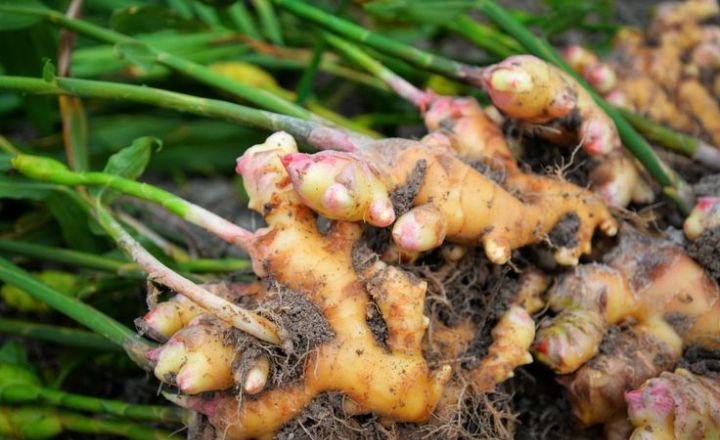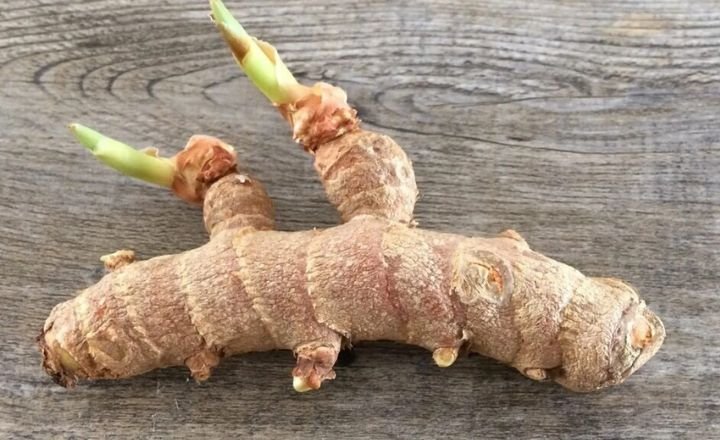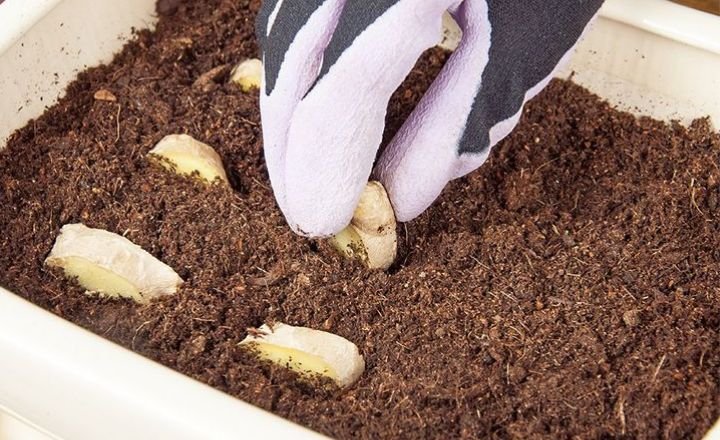Ginger, a remarkable rhizome celebrated for its culinary versatility and medicinal properties, has been cherished across cultures for centuries. How to grow ginger? Growing ginger at home allows you to enjoy the freshest flavors, reaping the health rewards right at your fingertips. Cultivating ginger can be an accessible and rewarding endeavor.
This complete guide will walk you through everything you need to know about how to grow ginger in various environments, ensuring that anyone, regardless of gardening experience, can quickly harvest their zesty rhizomes.
Understanding Ginger Root: Basics of Growth
Ginger’s scientific name, Zingiber officinale, hints at its exotic origins and rich history as a tropical plant. To cultivate this aromatic gem effectively, one must first grasp the best conditions for growing ginger root. Ginger thrives in warm and humid climates, nestled within well-drained soil that allows its roots to flourish without suffocating in soggy conditions.
Ginger thrives under specific climates and soil preferences that mimic its native tropical habitat; warm temperatures and high humidity are crucial for nurturing healthy growth. Equally important is well-drained soil that allows roots to spread freely without fear of rot.
How Long Does Ginger Take to Grow?
Ginger is an agricultural marvel that unfolds through distinct growing stages over an expected 8 to 10 months. From the initial planting of rhizomes to the moment you harvest those fragrant roots, each phase is filled with anticipation and care. Understanding the ginger growing stages is key for seasoned horticulturists and aspiring gardeners who wish to cultivate this tropical gem.
How to Grow Ginger Indoors
Choosing the right spot for growing ginger indoors needs to select a location that receives indirect sunlight for about 4-6 hours a day. South- or west-facing windows often provide the best light conditions, but if natural light is limited, consider using grow lights as a supplement. Ginger thrives in warm environments, so maintain a temperature between 70°F and 85°F to encourage robust growth. Avoid placing your plant near cold drafts or fluctuating temperatures, as this can stunt its development.

- Stage 1 Pre-Planting Preparation, where the soil is enriched, and the site is selected for optimal growth.
- Stage 2 ginger rhizomes are carefully planted in well-drained soil.
- Stage 3 sees the germination and early growth of the plants during weeks 2 to 4, as they emerge from the ground and begin to establish themselves.
- Stage 4 encompasses vegetative growth from weeks 4 to 6 onwards, where the plants develop lush foliage.
- Stage 5 Rhizome Development occurs over months 3 to 7 as the underground rhizomes mature and expand.
- Stage 6 Maturation and Harvest occur between months 8 and 10 when ginger is ready to be harvested.
- Stage 7 growers can engage in propagation for future crops by saving some of the harvested rhizomes for replanting.
How to Grow Ginger in Pots
When embarking on the journey of how to grow ginger in pots, the choice of container is paramount. Opt for a wide, shallow pot at least 12 inches deep, as ginger grows horizontally rather than vertically. This allows ample space for its rhizomes to spread out and flourish. Ensure your pot has drainage holes; proper drainage prevents waterlogging, leading to rot and jeopardizing your plant’s health.
Selecting the right potting mix is equally crucial for success. A well-draining blend of organic matter like compost or coconut coir mixed with perlite will provide optimal conditions for root development. Ginger thrives on consistent moisture, but avoid overwatering; a good rule of thumb is to water when the top inch of soil feels dry.
How to Grow Ginger in Water
Hydroponic methods for growing ginger offer an innovative approach that eliminates the mess of soil while still promoting robust growth. By harnessing water’s natural properties, plants can absorb nutrients more efficiently. This technique provides cleaner and hassle-free cultivation and allows interior growers to maintain a controlled environment, making it perfect for urban gardening enthusiasts with limited outdoor space.

To grow ginger in water, select a healthy piece of ginger with at least one eye or bud. Cut it into smaller sections and let them sit until a slight callus forms; this helps prevent rot. Place the cut pieces in a container filled with fresh water, ensuring that the eyes are submerged while the rest remain above water. Change the water every few days to keep it fresh and oxygenated while watching for roots to develop over time.
As roots establish and shoots emerge, transfer your thriving ginger plant into appropriate containers where ongoing growth can flourish without traditional soil maintenance. Ginger and rice, associated with conventional farming practices, can thrive in a hydroponic environment. Cultivating rice hydroponically opens doors to innovative agricultural practices that address food security concerns in densely populated regions
How to Grow Ginger in Cold Climates
How to grow ginger in cold climates can be a rewarding challenge with the right strategies. One effective approach is utilizing a greenhouse, which maintains a controlled environment that protects tender plants from frost. Installing additional insulation and heat sources, such as heating mats or passive solar designs, can create an ideal microclimate for your ginger.
For regions with shorter growing seasons, starting your ginger indoors 6-8 weeks before the last frost date is essential. This jump-start enhances growth potential and maximizes window sunlight exposure making lush leaf development more feasible. Once outside conditions become favorable, gradually acclimatize the young plants back to outdoor life by moving them outside for a few hours each day before full planting.
Growing ginger UK
Growing ginger in the UK can be a rewarding yet challenging endeavor. While not ideal, the temperate climate can still support this tropical plant with proper care and attention to its specific needs. One of the primary challenges is managing the cooler temperatures during germination; using a heated propagation mat or starting seeds indoors can significantly increase success rates.
Ginger thrives remarkably well in tropical regions where temperatures consistently hover above 70°F (21°C) due to the warm conditions and ample rainfall. These locales often benefit from rich, loamy soils that offer excellent drainage—a critical factor since ginger rhizomes are prone to rot in overly saturated environments.
How to grow ginger in Australia
Growing ginger in Australia thrives best in tropical and subtropical regions, where the warm climate and humidity mimic its native habitat. For Australian gardeners, selecting the right variety is essential; ‘Zingiber officinale’ is the most common type cultivated for culinary use.
Planting ginger rhizomes in well-draining, nutrient-rich soil enhances growth, and incorporating organic matter boosts moisture retention critically important during dry spells. Consideration of planting time can also significantly affect yields. The optimal window is late spring to early summer when temperatures consistently exceed 20°C, allowing ginger to establish itself before the cooler months arrive.
How to grow ginger in Florida
Florida’s warm and humid environment offers an ideal backdrop for growing ginger, making it one of the few places in the United States where this tropical plant thrives. To start with, select a well-draining, loamy soil rich in organic matter this will enhance moisture retention while preventing root rot. Plant your ginger rhizomes approximately 2-4 inches deep, spaced about a foot apart to allow them room to spread.
Common Challenges in Growing Ginger
Growing ginger can be rewarding but comes with its share of challenges. One prominent issue is the threat from pests like aphids and root-knot nematodes, which can devastate crops if not managed swiftly. Regularly inspecting plants for these intruders and utilizing natural pest deterrents, such as neem oil or companion planting with marigolds, can keep your ginger thriving.

Diseases like bacterial wilt may wreak havoc on yields; maintaining good air circulation and proper soil drainage are crucial preventative measures. Signs of poor growth often manifest, yet worryingly, yellowing leaves or roots that have turned mushy point to underlying problems. To combat yellowing leaves, check for nutrient deficiencies; incorporating compost enriched with nitrogen might rejuvenate your crop.
How to Grow Ginger: Easy 2025 Guide for Home Gardeners
Growing your own ginger at home is one of the most rewarding and surprisingly simple gardening projects you can dive into in 2025! Whether you have a spacious backyard, a cozy patio, or just a sunny spot on your windowsill, learning to cultivate ginger can give you fresh fragrant roots right at your fingertips.

In this updated guide we’ll take you through everything you need to know from selecting the best ginger roots to successfully harvesting them.
Why You Should Grow Ginger at Home
Ginger isn’t just your average spice; it’s a powerhouse of health benefits! When you grow your own ginger at home, you’ll find it’s way more aromatic, juicy, and flavorful than the stuff you buy at the store. Plus, cultivating your own ginger means you’re getting a fresh, organic product without any chemicals.
How to Grow Ginger: A Step-by-Step Guide
- Choose the Right Ginger Root
- Start by picking up some organic ginger rhizomes from a reliable supplier or your local grocery store.
- Look for pieces that are nice and plump, with those little “eyes” or buds (you know, those small bumps).
- Steer clear of any dried-out or shriveled roots.
Tip: If you soak the ginger root in warm water overnight, it can help it sprout faster!
- Pick the Perfect Spot
- Ginger thrives in warm, humid, and partially shaded areas.
- If you’re growing it indoors, try to place the pot near an east-facing window.
- For outdoor growing, find a spot that gets indirect sunlight.
Pro Tip: Ginger loves temperatures between 70°F to 90°F (21°C to 32°C) to really flourish.
- Prepare the Soil
- Make sure to use rich, well-draining soil that’s packed with organic matter.
- Keep the soil pH between 5.5 to 6.5 for the best results.
- Before planting, mix in some compost or aged manure to give it a nutrient boost.
- Plant Your Ginger
- When planting, bury the ginger pieces about 2-4 inches deep, with the buds facing up.
- If you’re planting several pieces, space them about 6-8 inches apart.
- After planting, give the soil a light watering.
- Caring for Your Ginger Plant
- Keep the soil nice and moist, but don’t let it get soggy.
- Fertilize once a month with an organic fertilizer that’s high in phosphorus.
- Adding mulch around the plant can help retain moisture and keep those pesky weeds at bay.
Important: Be careful not to overwater, as that can lead to root rot.
- Harvesting Ginger
- You can start harvesting baby ginger after about 4-6 months.
- If you’re waiting for mature ginger, give it around 8-10 months.
- When it’s time to harvest, gently dig up the rhizomes without disturbing the whole plant if you want to keep it growing.
Bonus Tips for Growing Ginger Successfully
- Container Growing: Ginger does really well in pots. Just make sure to use a wide, shallow container with good drainage.
- Winter Care: If you live in a colder climate, bring your pots indoors when temperatures dip below 50°F (10°C).
- Continuous Harvest: To keep your plant thriving, gently break off small pieces of the rhizome and then cover the remaining root with soil.
Conclusion
You can cultivate healthy ginger plants that flourish in any environment by ensuring proper drainage, providing adequate light, and maintaining consistent moisture levels. Growing ginger at home can be rewarding and straightforward when you follow the right steps. Remember to start with quality seed rhizomes and be patient as they mature.
No matter where you live, there’s always an opportunity to enjoy the tangy flavour of homegrown ginger in your culinary creations. Patience is key, as ginger takes time to mature, but the process is well worth it for fresh flavors and potential health benefits. Whether you use your homegrown ginger in cooking, teas, or natural remedies, you’ll appreciate the satisfaction of nurturing it from root to harvest.
FAQs
Can you grow ginger from a piece of ginger?
When preparing your rhizome, cut it into 3 cm long pieces, ensuring each piece has at least one or two ‘eyes.’ These are the small buds where new shoots will emerge.
What is the best fertilizer for ginger plants?
When it comes to fertilizing ginger plants, a balanced NPK ratio is indeed beneficial. A fertilizer with an equal ratio of 10-10-10 provides the essential nutrients.
